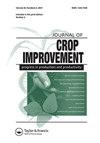Assessment of some sesame mutants under normal and water-stress conditions
IF 1.5
Q3 AGRONOMY
引用次数: 2
Abstract
ABSTRACT Sesame (Sesamum indicum L.) is a tropical oilseed crop that is also cultivated in arid and semi-arid environments, where drought occurs frequently. The objective of this study was to assess the performance of some sesame mutants, developed by our team through EMS-mutagenesis in 2020, under well-watered conditions and restricted irrigation by analyzing certain morphological, physiological, and agronomic attributes. The experiment was conducted in pots under field conditions according to a completely randomized design with three replications. The stress was simulated by suspending and reducing irrigation to 50% of the control, from the beginning of flowering until the appearance of the first capsule. The results showed variation attributable to genotypes, water regimes and their interaction was significant for all parameters studied, except the number of seeds per capsule. The mutants “ML2-5”, “ML2-72” and “ML2-37” were found to be the most tolerant to drought, exhibiting lowest stress sensitivity index and highest seed yield were associated with higher proline content in the leaves, more developed root system, higher chlorophyll content, and higher stomatal conductance than the rest of the mutants studied. This is the first report of sesame mutant lines with such high tolerance to drought during flowering. They could be used for developing high-performing cultivars with tolerance to drought during the flowering stage. The number of capsules per plant and stomatal conductance can be considered selection criteria to improve water-stress tolerance in sesame.一些芝麻突变体在正常和水分胁迫条件下的评价
芝麻(Sesamum indicum L.)是一种热带油料作物,在干旱频发的干旱和半干旱环境中也有栽培。本研究的目的是通过分析某些形态、生理和农艺性状,评估我们团队在2020年通过ems诱变技术获得的一些芝麻突变体在水分充足和限制灌溉条件下的表现。试验采用全随机设计,3个重复,在田间条件下盆栽进行。从开花开始到第一个蒴果出现,通过悬挂和减少50%的灌溉来模拟胁迫。结果表明,除每蒴果种子数外,基因型、水分状况及其相互作用对所有研究参数的影响均显著。突变体“ML2-5”、“ML2-72”和“ML2-37”对干旱的耐受性最强,胁迫敏感性指数最低,种子产量最高,叶片脯氨酸含量高,根系发达,叶绿素含量高,气孔导度高。这是首次报道具有如此高的开花期抗旱性的芝麻突变系。它们可用于培育花期抗旱高产品种。单株蒴果数和气孔导度可以作为提高芝麻抗旱性的选择标准。
本文章由计算机程序翻译,如有差异,请以英文原文为准。
求助全文
约1分钟内获得全文
求助全文
来源期刊

Journal of Crop Improvement
Multiple-
CiteScore
3.30
自引率
7.70%
发文量
42
期刊介绍:
Journal of Crop Science and Biotechnology (JCSB) is a peer-reviewed international journal published four times a year. JCSB publishes novel and advanced original research articles on topics related to the production science of field crops and resource plants, including cropping systems, sustainable agriculture, environmental change, post-harvest management, biodiversity, crop improvement, and recent advances in physiology and molecular biology. Also covered are related subjects in a wide range of sciences such as the ecological and physiological aspects of crop production and genetic, breeding, and biotechnological approaches for crop improvement.
 求助内容:
求助内容: 应助结果提醒方式:
应助结果提醒方式:


